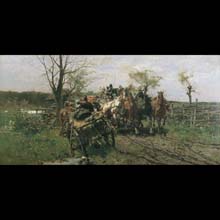
material: oil on canvas
dimensions: 100 × 200 cm
description: Józef Brandt was an unrivalled master of genre scenes. Everyday life, observed, for example, in the Eastern Borderlands of Poland provided him with a wealth of subjects. Above all, it served him as a pretext for painting works which represented essential artistic challenges. In these paintings, the artist combined his ability to arrange elaborate multi-figure scenes, compositional panache, a passion for portrayals filled with tension and dynamic movement, as well as decorativeness, vividness and the knowledge of the realities of borderland villages. A Meeting on a Bridge, with two horse carts trying to pass each other on a narrow, muddy road, is an excellent example of this type of works. A four-horse team, driven by an arrogant nobleman and his merry companions, has pushed a humble cart of a rural tar maker off the road. The composition is rendered in an early spring, grey, green and blue tonality, which appeared in Józef Brandt’s paintings after 1880, under the influence of French Impressionism. It was also then, according to Wacław Husarski, an opinion-forming art critic and expert, that “the dark brown sauce was replaced by the grey one, not necessarily more appropriate, as the seasoning added to the accurate drawing, inspired by Dutch painting, typical of the Munich circle.” On the other hand, Stanisław Witkiewicz – a painter and theoretician of realism, who appreciated the value of Brandt’s works – noticed that “the thing which is unique to Brandt is the real sense of colour harmony and understanding of the effect of the picturesque.” A Meeting on a Bridge is also an excellent example of not only the artist’s desire to paint scenes full of movement, but above all his successful attempts to create the impression of almost sound effects, enhancing both the dynamics and realism of the composition. Urszula Kozakowska-Zaucha
exposition: The Gallery of 19th Century Polish Art in Sukiennice,
The Cloth Hall, 1, Main Market Square
key: Realism, polish impressionism, beginnings of symbolism >>>
dimensions: 100 × 200 cm
description: Józef Brandt was an unrivalled master of genre scenes. Everyday life, observed, for example, in the Eastern Borderlands of Poland provided him with a wealth of subjects. Above all, it served him as a pretext for painting works which represented essential artistic challenges. In these paintings, the artist combined his ability to arrange elaborate multi-figure scenes, compositional panache, a passion for portrayals filled with tension and dynamic movement, as well as decorativeness, vividness and the knowledge of the realities of borderland villages. A Meeting on a Bridge, with two horse carts trying to pass each other on a narrow, muddy road, is an excellent example of this type of works. A four-horse team, driven by an arrogant nobleman and his merry companions, has pushed a humble cart of a rural tar maker off the road. The composition is rendered in an early spring, grey, green and blue tonality, which appeared in Józef Brandt’s paintings after 1880, under the influence of French Impressionism. It was also then, according to Wacław Husarski, an opinion-forming art critic and expert, that “the dark brown sauce was replaced by the grey one, not necessarily more appropriate, as the seasoning added to the accurate drawing, inspired by Dutch painting, typical of the Munich circle.” On the other hand, Stanisław Witkiewicz – a painter and theoretician of realism, who appreciated the value of Brandt’s works – noticed that “the thing which is unique to Brandt is the real sense of colour harmony and understanding of the effect of the picturesque.” A Meeting on a Bridge is also an excellent example of not only the artist’s desire to paint scenes full of movement, but above all his successful attempts to create the impression of almost sound effects, enhancing both the dynamics and realism of the composition. Urszula Kozakowska-Zaucha
exposition: The Gallery of 19th Century Polish Art in Sukiennice,
The Cloth Hall, 1, Main Market Square
key: Realism, polish impressionism, beginnings of symbolism >>>












